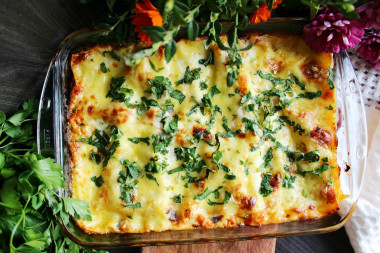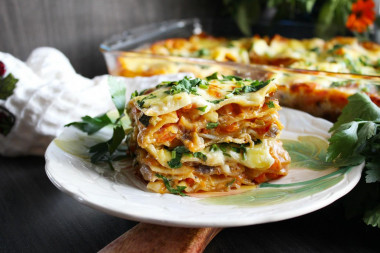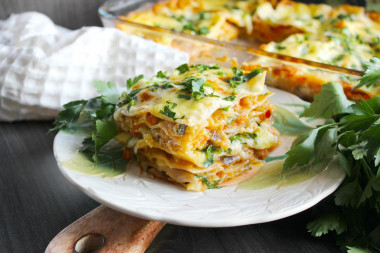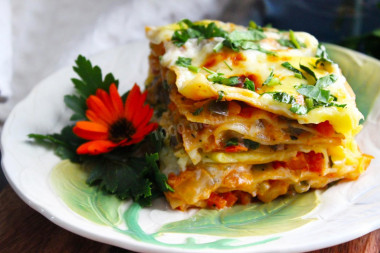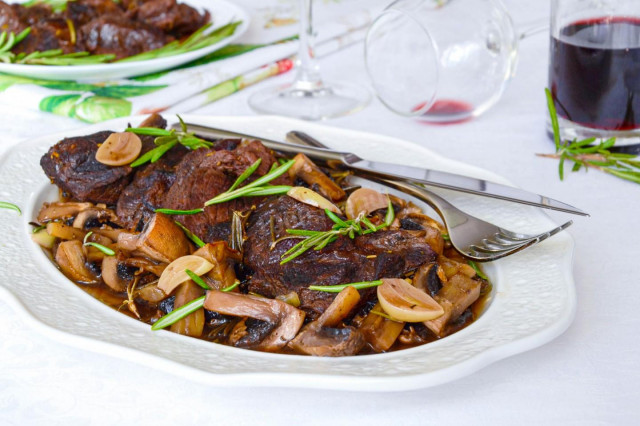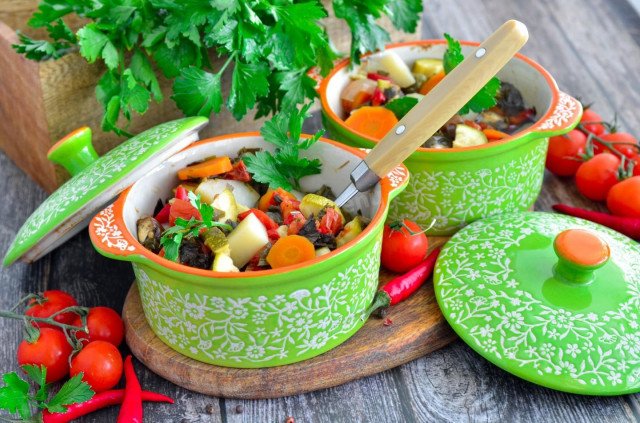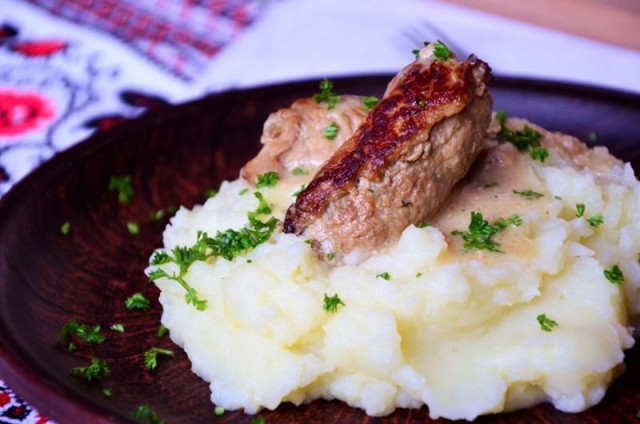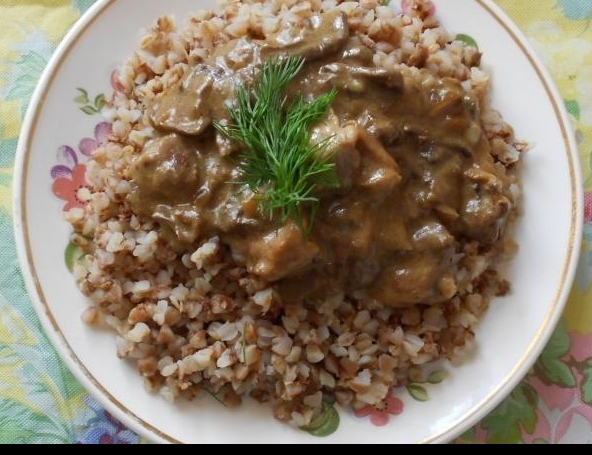Composition / ingredients
Step-by-step cooking
Step 1:
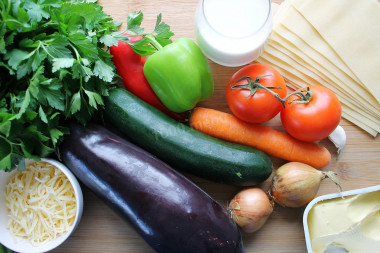
Prepare the vegetables for the filling. We will need: eggplant, zucchini, bell pepper, onion, carrot, tomatoes and garlic.
Step 2:
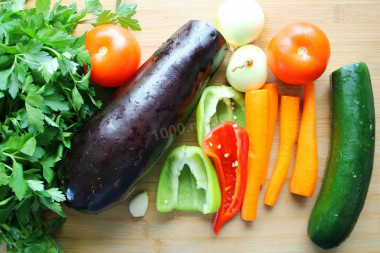
Wash vegetables under running water. In zucchini and eggplant, cut off the stalks, do the same with Bulgarian pepper and peel it from the seeds (for the brightness of the finished dish, peppers were used in the recipe of different colors). Peel the onion, carrot and garlic.
Step 3:
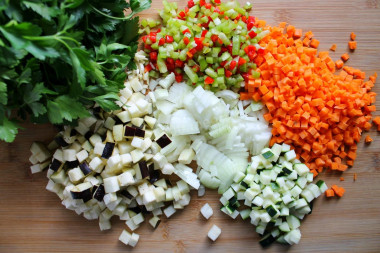
Cut all vegetables into small cubes (try to make the size of the cubes as much as possible the same, so in the finished lasagna the filling will look more appetizing and more beautiful).
Step 4:

Heat vegetable oil in a frying pan, add onion and carrot to it. Stir constantly, fry the vegetables until the onion has a golden hue.
Step 5:
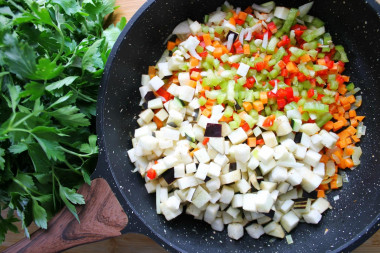
Next, put the bell pepper and eggplant in the pan. Fry everything together for about five minutes. Do not forget to stir the vegetables periodically, otherwise they may burn.
Step 6:

The next step is to put zucchini, tomatoes and tomato paste in the pan. Add salt and pepper to taste. Stir the vegetables, reduce the heat to medium and simmer everything under a half-closed lid for about five to ten minutes. If tomatoes are out of season and almost tasteless, which happens in winter and spring, then it is worth adding a pinch of sugar to the vegetable stew.
Step 7:
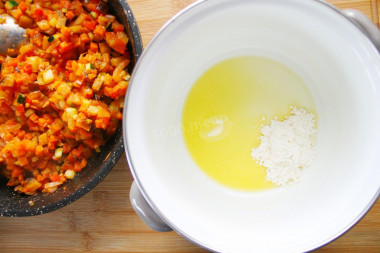
While the vegetables for the filling are cooling, prepare the Bechamel sauce. To do this, melt the butter in a small saucepan, add the flour and, stirring constantly with a whisk, fry it for a few seconds.
Step 8:
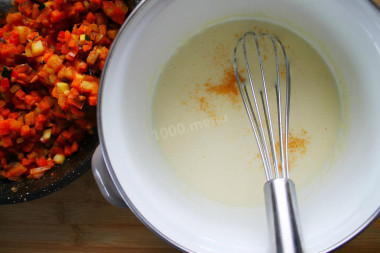
Add milk, a pinch of salt, ground pepper to taste and a little nutmeg. Constantly stirring, cook everything until lightly thickened. Remove the sauce from the heat and cool slightly.
Step 9:
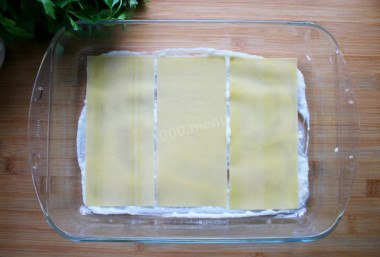
When all the basics are ready, you can start assembling the lasagna. Grease the bottom of the mold with vegetable oil. Pour a little Bechamel sauce, spread evenly over the entire surface. Put the lasagna sheets on top (see the instructions for preparing the sheets on the package, it is quite possible that they need to be boiled beforehand).
Step 10:

Grease the sheets again with Bechamel sauce and lay out an even layer of vegetable filling (about 1-1.5 cm thick).
Step 11:

Sprinkle the vegetable stew with grated cheese on top.
Step 12:
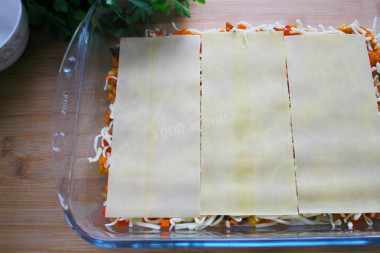
Then repeat all the layers until the ingredients run out.
Step 13:
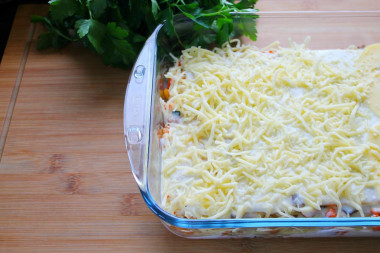
The last layer should be lasagna sheets, pour the sauce over them and sprinkle liberally with cheese. Cover the mold with a lid or foil and send it to the oven at 180-200 degrees for 30-40 minutes (you should focus on the capabilities of your oven).
Step 14:

Next, remove the lid (foil) and leave the lasagna for another 5-10 minutes so that the cheese turns brown and the dish takes on an appetizing appearance. Let the lasagna brew for a few minutes at room temperature and sprinkle with chopped herbs.
Before serving, cut the lasagna in portions into even squares or rectangles. The finished dish can be served to the table!
In the recipe, I used a glass mold, measuring 30*20 cm and 4-5 cm deep. It was enough for 6 full portions for dinner. The thickness of the vegetable filling can be made larger, for this you should increase the number of vegetables.
At the stage of cooking vegetable stew, you can add your favorite spices to the pan, as well as use a pinch of hot chili pepper if desired.
Cabbage, green asparagus, peas and other vegetables that are available are added to vegetable lasagna.
Try to experiment and choose for yourself and your family the most delicious vegetable filling for lasagna.
Bon appetit!
Calorie content of the products possible in the dish
- Onion - 41 kcal/100g
- Tomatoes - 23 kcal/100g
- Whole cow's milk - 68 kcal/100g
- Milk 3.5% fat content - 64 kcal/100g
- Milk 3.2% fat content - 60 kcal/100g
- Milk 1.5% fat content - 47 kcal/100g
- Concentrated milk 7.5% fat content - 140 kcal/100g
- Milk 2.5% fat content - 54 kcal/100g
- Zucchini - 23 kcal/100g
- Sweet pepper - 27 kcal/100g
- Carrots - 33 kcal/100g
- Dried carrots - 275 kcal/100g
- Boiled carrots - 25 kcal/100g
- Eggplant - 24 kcal/100g
- Dutch cheese - 352 kcal/100g
- Swiss cheese - 335 kcal/100g
- Russian cheese - 366 kcal/100g
- Kostroma cheese - 345 kcal/100g
- Yaroslavsky cheese - 361 kcal/100g
- Altai cheese 50% fat content - 356 kcal/100g
- Soviet cheese - 400 kcal/100g
- Cheese "steppe" - 362 kcal/100g
- Uglich cheese - 347 kcal/100g
- Poshekhonsky cheese - 350 kcal/100g
- Lambert cheese - 377 kcal/100g
- Appnzeller cheese with 50% fat content - 400 kcal/100g
- Chester cheese with 50% fat content - 363 kcal/100g
- Edamer cheese with 40% fat content - 340 kcal/100g
- Cheese with mushrooms of 50% fat content - 395 kcal/100g
- Emmental cheese with 45% fat content - 420 kcal/100g
- Gouda cheese with 45% fat content - 356 kcal/100g
- Aiadeus cheese - 364 kcal/100g
- Dom blanc cheese (semi-hard) - 360 kcal/100g
- Cheese "lo spalmino" - 61 kcal/100g
- Cheese "etorki" (sheep, hard) - 401 kcal/100g
- White cheese - 100 kcal/100g
- Fat yellow cheese - 260 kcal/100g
- Altai cheese - 355 kcal/100g
- Kaunas cheese - 355 kcal/100g
- Latvian cheese - 316 kcal/100g
- Limburger cheese - 327 kcal/100g
- Lithuanian cheese - 250 kcal/100g
- Lake cheese - 350 kcal/100g
- Gruyere cheese - 396 kcal/100g
- Garlic - 143 kcal/100g
- Ground black pepper - 255 kcal/100g
- Whole durum wheat flour fortified - 333 kcal/100g
- Whole durum wheat flour universal - 364 kcal/100g
- Flour krupchatka - 348 kcal/100g
- Flour - 325 kcal/100g
- Granulated sugar - 398 kcal/100g
- Sugar - 398 kcal/100g
- Butter 82% - 734 kcal/100g
- Amateur unsalted butter - 709 kcal/100g
- Unsalted peasant butter - 661 kcal/100g
- Peasant salted butter - 652 kcal/100g
- Melted butter - 869 kcal/100g
- Vegetable oil - 873 kcal/100g
- Tomato paste - 28 kcal/100g
- Salt - 0 kcal/100g
- Lasagna sheets - 337 kcal/100g
- Nutmeg - 556 kcal/100g


